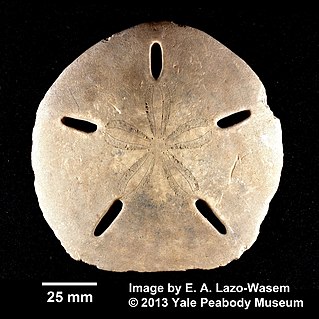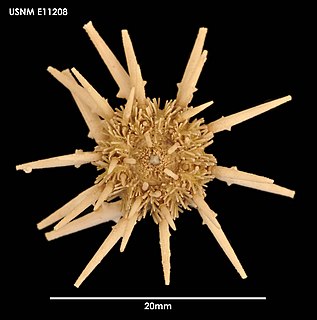
The guenons are Old World monkeys of the genus Cercopithecus. Not all members of this genus have the word "guenon" in their common names; also, because of changes in scientific classification, some monkeys in other genera may have common names that include the word "guenon". Nonetheless, the use of the term guenon for monkeys of this genus is widely accepted.

The blue monkey or diademed monkey is a species of Old World monkey native to Central and East Africa, ranging from the upper Congo River basin east to the East African Rift and south to northern Angola and Zambia. It sometimes includes Sykes', silver, and golden monkeys as subspecies.

The Aspidodiadematidae are a family of sea urchins.
The World Register of Marine Species (WoRMS) is a taxonomic database that aims to provide an authoritative and comprehensive list of names of marine organisms.
Cassiduloida is an order of sea urchins. The group was extremely diverse with many families and species during the Mesozoic, but today, only seven extant species remain.

The Echinacea are a superorder of sea urchins. They are distinguished by the presence of a rigid test, with ten buccal plates around the mouth, and solid spines. Unlike some other sea urchins, they also possess gills. The group is a large one, with species found worldwide.

The Camarodonta are an order of globular sea urchins in the class Echinoidea. The fossil record shows that camarodonts have been in existence since the Lower Cretaceous.

Agassizia scrobiculata is a species of sea urchin of the family Prenasteridae.

Araeosoma thetidis is a species of sea urchin of the family Echinothuriidae. This species can be found in deep sea off Australia and New Zealand. A. thetidis was first scientifically described in 1909 by Hubert Lyman Clark.

Echinometra is a genus of sea urchins in the family Echinometridae.

Astriclypeus mannii is a species of sea urchin of the family Astriclypeidae. Their armour is covered with spines. It is placed in the genus Astriclypeus and lives in the sea. Astriclypeus mannii was first scientifically described in 1867 by Verrill.
Calymne relicta is a species of sea urchins of the Family Calymnidae. Their armour is covered with spines. Calymne relicta was first scientifically described in 1877 by Thomson.

Cassidulus caribaearum is a species of sea urchins of the family Cassidulidae. Their armour is covered with spines. Cassidulus caribaearum was first scientifically described in 1801 by Jean-Baptiste de Lamarck.
Cassidulus delectus is a species of sea urchin of the family Cassidulidae. Their armour is covered with spines. Cassidulus delectus was first scientifically described in 1960 by Krau.
Cassidulus infidus is a species of sea urchin of the family Cassidulidae. Their armour is covered with spines. Cassidulus infidus was first scientifically described in 1948 by Ole Theodor Jensen Mortensen.

Centrocidaris is a monotypic genus of sea urchins belonging to the family Cidaridae. The only species is Centrocidaris doederleini. Their armour is covered with spines. Centrocidaris doederleini was first scientifically described in 1898 by Alexander Agassiz.

The infraclassis Carinacea includes most living species of regular sea urchin, and fossil forms going back as far as the Triassic.

Myriotrochus is a genus of sea cucumbers. The following species are recognised in the genus Myriotrochus:

Goniocidaris umbraculum is a species of cidaroid sea urchin that inhabits the continental shelf off the southern coasts of New Zealand. It is plentiful on a seabed composed of seashell and bryozoan rubble at a depth of 95 m (310 ft) off Otago.
Cassidulus is a genus of echinoderms belonging to the family Cassidulidae.














